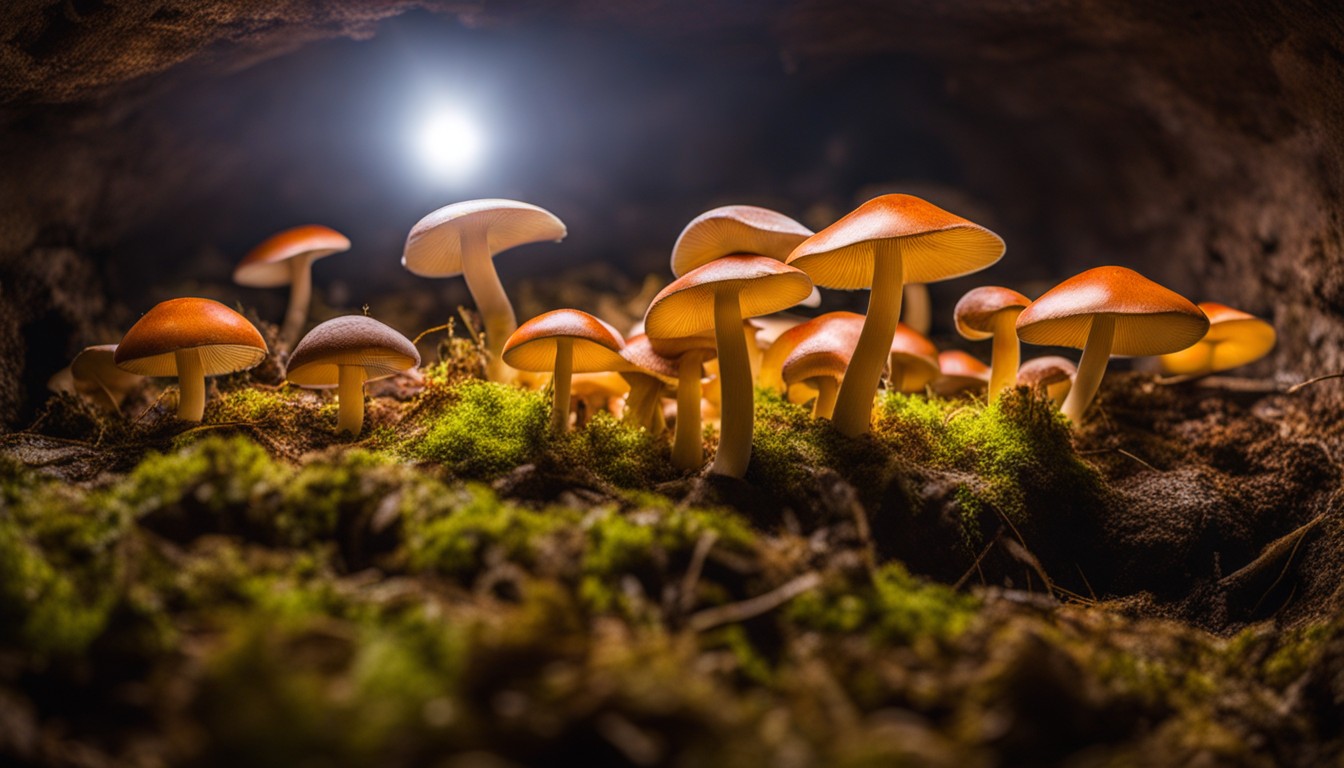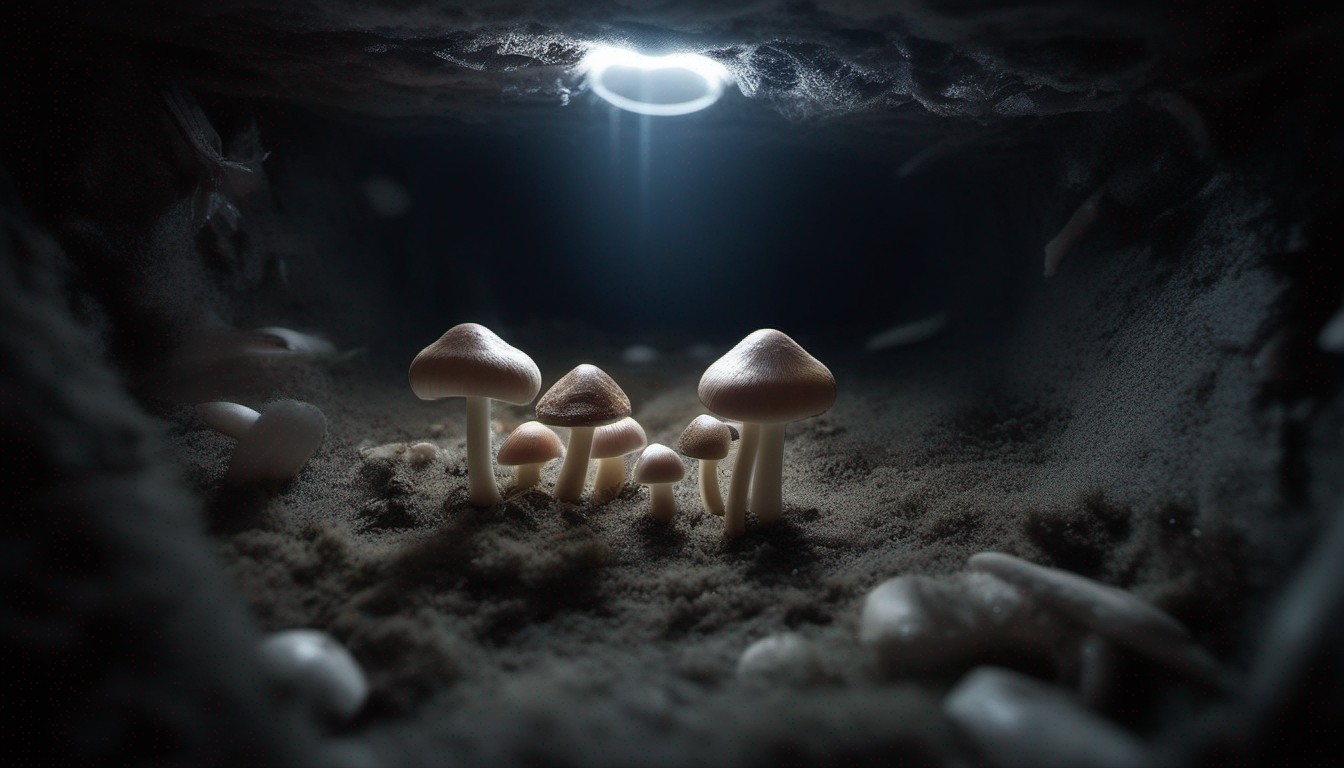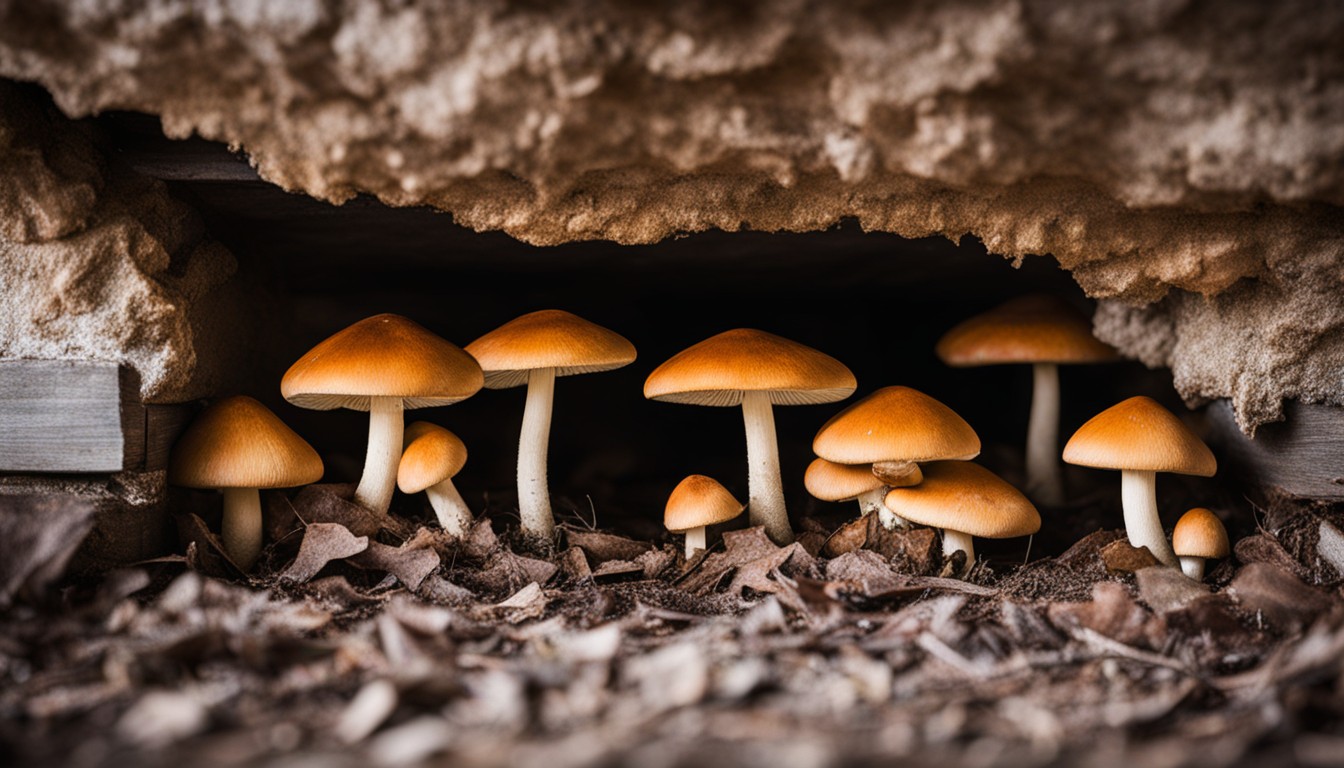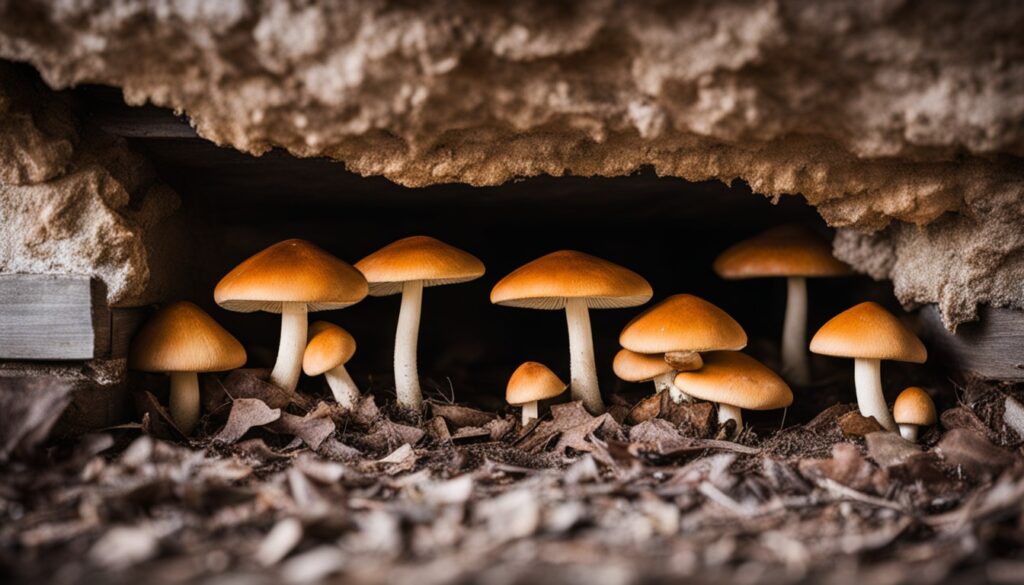If left unaddressed, mushrooms in crawl spaces can not only affect the structural integrity of your home but also pose health risks to you and your family. In this detailed guide, we will delve into the different types of mushrooms commonly found in crawl spaces, their potential hazards, and the importance of early detection. We will also explore the various causes of mushroom growth, such as excessive moisture, inadequate drainage, or organic material decomposition. Additionally, we will provide step-by-step instructions on how to effectively remove mushrooms and prevent their recurrence, ensuring a clean and healthy crawl space environment for years to come.
Identifying and Understanding Mushroom Growth
Mushrooms, scientifically known as fungal fruiting bodies, sprout from mycelia—masses of threadlike cells. They act as the reproductive structure of the fungus, releasing spores that allow colonization in new habitats.
Mushrooms’ unique growth patterns are influenced by environmental conditions such as humidity, temperature, and light. Thus, damp, dark and confined spaces like crawl spaces provide an ideal environment for their proliferation.
Types of Mushrooms Found in Crawl Spaces
Mushrooms present in crawl spaces take many forms, not all of which are benign. From common fungal invaders to potentially toxic species, it’s essential to understand what you’re dealing with.
- Common Fungal Invaders: Often harmless but invasive, some common types include the white rot, brown rot, and dry rot fungi.
- Edible Versus Toxic: While it’s rare to find edible mushrooms in crawl spaces, varieties such as the wild puffball and fairy ring could appear. However, toxic species like the death cap or destroying angel are more prevalent; hence distinguishing between them is crucial.
Causes of Mushroom Growth in Crawl Spaces
The primary cause of mushroom growth in crawl spaces is the presence of moisture, combined with other factors such as high humidity, lack of proper ventilation, and the presence of organic material, which provides a favorable environment for fungus growth.
- Excess moisture from leaky pipes or condensation, High humidity levels, Poor ventilation leading to damp conditions, Organic material such as wood or soil acting as a food source for mushrooms
Potential Risks and Hazards of Mushroom Growth in Crawl Spaces
Mushrooms growing in crawl spaces can compromise building structure and impair indoor air quality, posing considerable risk to both property and inhabitants.
- Mushrooms can induce wood rot, undermining the structural integrity of the building.
- Certain types of mushrooms produce spores that, when inhaled, may lead to respiratory issues such as allergies and asthma.
- Persistent fungal growth leads to the production of mycotoxins known to be harmful to human health.
- Undetected mushroom growth can lead to large-scale infestations that are difficult and costly to remedy.
Addressing Mushroom Growth in Crawl Spaces
On addressing mushroom growth, the extent of the infestation determines the course of action. Pure fungi resurgence requires professional assistance, whereas minor cases may respond to DIY methods. For prevention, moisture control, ventilation and regular maintenance are vital to keep crawl spaces fungi-free.
Assessing the Severity of Mushroom Infestation
Assessing the severity of a mushroom infestation in your crawl space is the initial step in the remediation process. It helps to determine the type and magnitude of treatment required.
- Proliferating mushroom clusters.
- Large-scale spore dispersal
- Compromised building materials
- Foul odors emanating from the crawl space
- Increased moisture and dampness
Safe Removal and Remediation Techniques
Safe and efficient removal of mushrooms from crawl spaces requires both precautionary measures and effective remediation techniques. It’s crucial to safeguard your health while eliminating the fungal growth, and adopt methods that address the root causes of the issue.
- Wear proper protective gear, including respirators, goggles, and gloves.
- Identify and isolate the affected areas to prevent the spread of spores.
- Adopt mechanical removal techniques, such as scrubbing or vacuuming with a HEPA filter.
- Consider the use of bio-remediation strategies, which utilize beneficial bacteria or fungi to combat mushroom growth.
- Ensure professional-grade anti-fungal treatments are applied to affected surfaces.
- After removal, thermographic inspections can be used to confirm complete remediation.
Preventing Future Mushroom Growth in Crawl Spaces
An effective strategy to prevent future mushroom growth in crawl spaces is through meticulous cleanliness and reducing dampness. Keeping these areas clean and dry takes away the organic, moist environment fungi thrive in.
Maintaining cleanliness, reducing dampness, and ensuring air flow in crawl spaces can create a hostile environment for mushroom growth, helping to prevent fungal proliferation.
Understanding the requirements of mushroom growth equips you to make spaces less conducive to their proliferation. Mushrooms require darkness, moisture, and organic matter to grow. Thus, denying fungi these conditions retards their growth.
Regular moisture checks in your crawl spaces are crucial for sustained prevention. Investing in a humidity monitor, and acting swiftly if levels rise above 50%, can keep fungal growth in check.
Ventilation plays a key role in mushroom-proofing your crawl space. By ensuring that air circulates continuously, you effectively drop humidity levels and create a hostile environment for mushrooms.
Hiring a Professional for Mushroom Removal

The efficiency and assurance of a service delivered by a professional mushroom remover make their engagement crucial. Equipped with advanced techniques and in-depth knowledge, professionals ensure comprehensive removal without risking further contamination.
When hiring a professional for mushroom removal, it’s vital to prioritize expertise and familiarity with local regulations. Ascertain their certification, review prior experience, inquire about their tools and methods, and ensure they offer a comprehensive service from assessment to prevention.
Benefits of Hiring a Professional Mushroom Removal Service
Professional mushroom removal services pinpoint the exact source of fungal growth, thus completely eradicating the infestation and impeding future growth. Their methodical approach restricts the possibility of overlooked areas, ensuring a comprehensive cleanse of the space.
Hiring an expert can save you valuable time and unnecessary expenses. By applying their experience and sophisticated equipment, professionals efficiently remove mushrooms, preventing costly structural damages and saving your time spent on DIY attempts.
Your health is of paramount importance. Inhaling fungal spores could lead to respiratory issues and other health concerns. By entrusting the task to professionals, you minimize exposure to potential allergens and toxins, safeguarding your health.
Choosing the Right Professional for Mushroom Removal
When sourcing a mushroom removal service, scrutiny of credentials is imperative. These include licenses, certifications and accreditations by respected industry bodies accounting for professionalism and proficiency.
Certifications in fungal biology, mycology or environmental health highlight specialists in the field. It suggests their service is not only capable but also informed, being well-equipped to handle complex situations.
Experience further fortifies a professional’s repertoire. Check for companies boasting a history in the field, indicating a track record of effectively addressing similar issues.
Reviews and testimonials can offer insights into a professional’s experience. They reveal their consistency, customer experience, and effectiveness, providing vital information for your decision-making process.
Questions to Ask When Hiring a Professional Mushroom Removal Service
It is imperative to inquire about the techniques a professional service will employ for mushroom remediation. This gives you an idea of their expertise and ensures that the process is safe for the surroundings and inhabitants.
Question the service provider about the duration it usually takes for mushrooms to reappear post-removal. Their answer will give you insight into the effectiveness of their procedures.
Make sure to ask about the aftercare support the company provides. Post-treatment support may include re-inspection, maintenance advice, and remedying any potential recurrence in the future.
DIY Methods for Mushroom Removal

Homemade remedies, such as a vinegar or baking soda solution, can be an initial step in eradicating mushrooms. They are useful for deactivating spores and suppressing growth but require consistent application.
Over-the-counter fungicides prove highly effective in mushroom removal. They eliminate existing mushrooms and their spores, breaking the growth cycle. However, their application should adhere to safety guidelines, given their chemical composition.
Safety Precautions for DIY Mushroom Removal
Before embarking on DIY mushroom removal, adequately protecting oneself is paramount. Essential Personal Protective Equipment (PPE) includes gloves, a face mask or respirator, and eye protection. These are required to protect from spore inhalation and skin contact.
In addition to PPE, protective clothing such as a long-sleeved shirt, long pants, and work boots should be worn to limit skin exposure to potentially harmful fungi during the removal process.
DIY mushroom removal also requires vigilance to avoid hazardous situations. If you suspect the presence of poisonous mushrooms or if the infestation is extensive, this warrants a professional inspection and possible removal.
Finally, always ensure the crawl space is structurally sound before entering. Any signs of compromised integrity like rot, cracks, or damp-related damage require immediate professional assessment.
Tools and Materials Needed for DIY Mushroom Removal
For a successful DIY mushroom removal, it’s essential to equip yourself with the right tools, of which the first is a disposable coverall suit, gloves, and breathing mask to prevent contact with mushroom spores. Additionally, a flashlight or headlamp will provide needed illumination in the dark corners of a crawl space.
An essential component for rearing a bacteria-free environment is a mix of hydrogen peroxide and water, accompanied by a garden sprayer for application. The solution not only annihilates existing mushrooms but prevents the growth of new ones.
Leveraging a mold-controlling fogging machine will enhance your removal process. It releases a mist that infiltrates hard-to-reach areas, ensuring even the most stubbornly hidden mushrooms are exposed and eradicated.
Durable, heavy-duty garbage bags are necessary for safe disposal of fungus-infected materials. Specialized spore-trapping vacuum cleaners also come handy to hoover up lingering spores and discourage future growth. Accumulated debris calls for a heavy-duty broom and dustpan.
Lastly, a moisture meter provides invaluable data on your crawl space’s humidity levels, a major contributor to mushroom growth. Keeping track of this data equips you to effectively stop future infestations before they take hold.
Step-by-Step Guide for DIY Mushroom Removal
To unveil the secrets of mushroom extraction, you must first locate and identify the type of mushrooms in your crawl space. From there, removal necessitates proper personal protective equipment (PPE) – sealed goggles, gloves, and a respirator or face mask to protect against spores.
The following are the key elements of a pro-active four-step DIY mushroom removal strategy: Locating the supply, extracting the fungi, cleaning and sterilizing the area, and maintaining it to prevent recurring growth.
Understanding the nuances of mushroom removal requires attention to detail: the ‘root’ system (mycelium) must be fully excavated. Any residual mycelium could lead to regrowth. Once removed, dispose of the mushrooms and infested materials in sealed bags.
Maintenance Tips to Prevent Future Mushroom Growth

Implementing proactive measures towards preventing the recurrence of mushrooms in your crawl space, such as the use of anti-fungal treatments and consistent, targeted cleaning, is essential.
Future-proofing your home by curbing mushroom proliferation involves strategic alterations and revisions in crawl space design such as improved ventilation and enhanced moisture control.
Regular Inspections and Maintenance of Crawl Spaces
Regular inspections play a pivotal role in mitigating fungal growth, enabling early detection of any signs of mushroom invaders. This preventive measure leads to timely intervention, thus disrupting the lifecycle of the fungi before it proliferates.
Performing regular checks and maintaining the overall health of crawl spaces are essential. These maintenance tasks ensure an ideal environment is not provided for mushroom growth, preserving the structural integrity of your home and protecting your health against potential fungal hazards.
Moisture Control and Ventilation Strategies
Deploying robust moisture control and ventilation tactics can severely hinder mushroom growth. These powerful prevention methods aim to eliminate damp conditions and maintain low humidity levels, creating an inhospitable environment for fungi.
Adopting smart strategies for drying and ventilating crawl spaces further strengthens fungal control. Regularly airing out these confined areas can dry out wood and soil, removing the moisture mushrooms need to thrive, while also improving overall indoor air quality.
FAQ: Mushrooms in Crawl Space
What are the signs of mushrooms in a crawl space?
Mushrooms in a crawl space can be identified by visible growth of fungal organisms, musty odors, discoloration of surfaces, presence of mushroom spores, and decaying organic matter.
Are mushrooms in a crawl space harmful?
Certain types of mushrooms can release spores that can pose health risks, especially for individuals with respiratory issues or allergies. Additionally, some mushrooms can cause structural damage to wood and other materials in the crawl space.
How do I remove mushrooms from my crawl space?
To safely remove mushrooms from a crawl space, it’s crucial to wear protective gear, manually remove visible mushrooms, address the underlying moisture issue, consider applying fungicides, and implement preventive measures to inhibit further growth.
What causes mushrooms to grow in crawl spaces?
Mushrooms typically grow in crawl spaces due to excess moisture, inadequate ventilation, presence of organic matter like wood or insulation, warm temperatures, and poor drainage systems.
How can I prevent mushrooms from growing in my crawl space?
Preventive measures include ensuring proper ventilation, fixing any water leakage or drainage issues, reducing humidity levels, encapsulating the crawl space, using dehumidifiers, and keeping the crawl space clean and free from organic materials.
Should I consult a professional for mushroom infestation in my crawl space?
If the mushroom infestation is severe, recurring, or you are unsure about handling the situation, it is advisable to contact a professional who can assess the extent of the problem, provide appropriate solutions, and ensure effective eradication of mushrooms in your crawl space.
Remember, addressing mushrooms in a crawl space promptly is crucial to prevent potential damage to your home, safeguard your health, and maintain a clean and safe living environment.
Conclusion
In conclusion, controlling mushroom growth in your crawl spaces requires knowledge, meticulousness, and action. Encountering mushrooms may seem a small issue, but it symbolizes potential larger concerns within your property.
In sum, battling against crawl space mushrooms isn’t just about removing visible growth. It encompasses a comprehensive approach: evaluating the extent of infestation, executing safe removal, ensuring preventive measures, and maintaining a healthy crawl space.
- Understand the types of mushrooms prevalent in crawl spaces.
- Identify causes leading to mushroom growth in your spaces.
- Learn about potential risks and hazards of mushroom growth.
- Evaluate the severity of mushroom infestation.
- Master safe removal and remediation techniques.
- Adopt preventive tactics against mushroom growth in crawl spaces.
- Hire professional help when necessary and validate their credentials.
- Try DIY methods for mushroom removal, ensuring safety and proper use of tools.
- Incorporate regular inspections and maintenance of crawl spaces.
- Implement moisture control and ventilation strategies.

